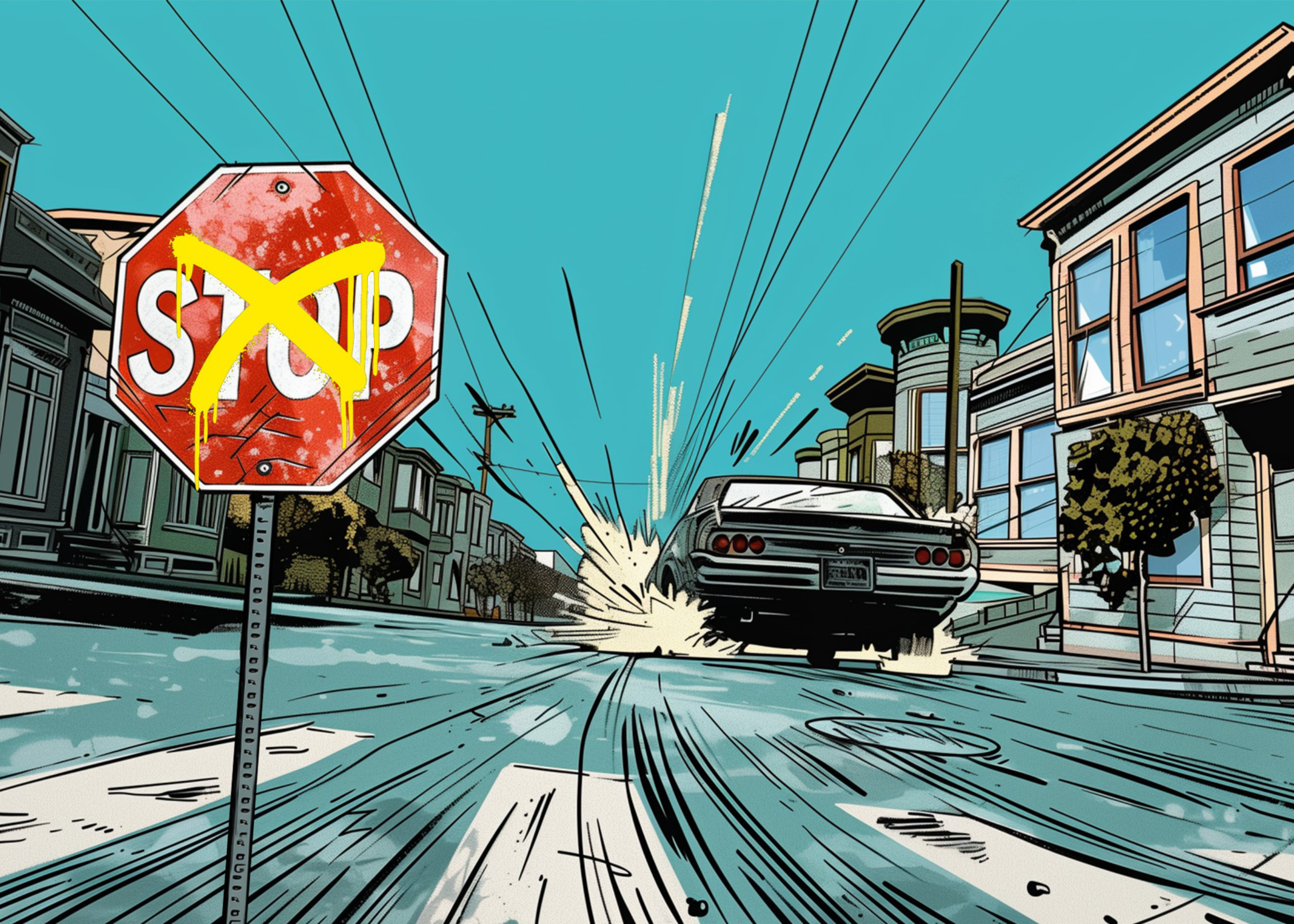On a brilliantly sunny Thursday last week, I watched as San Francisco Mayor London Breed and a mini-brigade of government officials and transportation activists took to the steps of City Hall to discuss the darkest of subjects: the city’s pathetic results in protecting pedestrians from being killed by motorists.
Breed’s speech was forceful, and her choice of allies spoke to her aspirations. Pedestrian and cycling advocates stood beside her with signs that symbolized their common agenda, like “Safe Streets Spark Joy” and “End Traffic Violence.” The often-voluble citizens who pipe up at other public forums in defense of parking and car-friendly thoroughfares were neither seen nor heard.
Yet even while Breed was plainly aware of the city’s lack of progress in maintaining street safety, what was unsaid—about deterrence and attitudes and political will—left me wondering if radical change actually was afoot.
The City Hall event marked the 10-year anniversary of the city’s “VisionZero” pledge (opens in new tab), adopted from an international movement of anti-car and pro-pedestrian-and-cyclist urban activists. The goal, per the “zero” in the slogan, was to eliminate all traffic fatalities. But the campaign has simply not worked: There were 34 deaths in 2013, the year before the city adopted its Vision Zero goal. There were 39 fatalities (opens in new tab)in 2022, 26 last year and already 11 deaths in 2024.
Despite the rah-rah tone of the mayor’s event, the disappointment at the lack of progress was palpable. And some of the defenses were truly weak. “While it may not seem that way, we have been saving lives,” said David Chiu, the city attorney, touting policy enhancements over his years as a San Francisco supervisor and state assemblymember. At the end of the day, though, Chiu acknowledged, “great cities don’t see the number of deaths we’ve had.”
While Breed announced several policy goals—increasing enforcement of “daylighting” measures meant to restrict parking near dangerous intersections; expanding the list of streets where right turns on red lights are prohibited; and stepping up policing of unsafe driving—the fine print on the mayor’s directives betrayed the limits of her aggressiveness.
As is so often the case in this process-obsessed city, Breed’s words were just that—words—that signaled a desire to unshackle bureaucracy, with details to be determined. What she didn’t want to talk about—her police department’s inability to enforce traffic laws, and her residents’ seeming unwillingness to follow them—is where the rubber of Vision Zero truly meets the road.
‘A lose-lose proposition’
Over the course of the past few weeks—before the March 16 car crash at a West Portal bus stop that killed a beautiful young family and threw the city into mourning—I had begun my own quest to understand the simplest of traffic problems. I wanted to know why San Franciscans habitually blow through stop signs.
I should have known my simple inquiry would lead me into a maze of bureaucratic and policy confusion, which would funnel me back to the simplest of answers. There are many culprits for our unsafe streets, but this one is the clearest: In recent years, the San Francisco Police Department has all but ceased writing tickets for stop sign infractions. The department issued 68 citations for blown stop signs in January. It wrote nearly 14 times as many, 940, in the same month a decade ago. Enforcement of other violations has followed a similar trajectory (opens in new tab).
San Francisco cops have never loved writing tickets. “It’s a lose-lose proposition for a police officer to pull someone over,” a department lifer tells me. They hate showing up in court only to find the ticketed offender hasn’t bothered to do the same.
Their distaste for traffic stops was further enabled when the Police Commission prohibited certain kinds of stops (though not for running a stop sign) earlier this year. And a 2015 state law (opens in new tab) added paperwork to ensure that police aren’t racially profiling suspected offenders.
Yet beyond all those contributing factors, it’s understaffing, not laziness, that is the primary reason enforcement is down, according to police officials. The SFPD is currently short a total of 542 officers. Fewer cops on the street mean fewer driving violation tickets, especially given that the department’s priority—appropriately—remains violent crime.
Even still, a consensus is forming that without more aggressive enforcement of traffic law, driver behavior will never change. Myrna Melgar, the supervisor whose district includes West Portal, likens the lack of deterrence to her pre-supervisor days heading an organization that worked with teenagers outside of school. “One of the rules of youth development is that you don’t go from more discipline to less discipline,” she says. “That’s how you lose control of the classroom.”
Meglar maintains that San Francisco drivers are essentially behaving like any reasonable person would in an environment where there’s no threat of punishment.
This, to my ears, is an irrefutable argument. And it jibes with my own experience on our streets, or at least to my behavior as a cyclist. (I drive, too, but I prefer, if I possibly can, to bike from place to place around SF.) Like many cyclists, I frequently hurtle past stop signs without coming to a full stop, as the law requires. However, if I thought there was a reasonable likelihood I’d be ticketed for not doing so, I’d clean up my act.
‘A Band-Aid on a gushing wound’
Seemingly getting the message that the grownups are watching, the San Francisco police have been doing better on traffic enforcement recently—or at least trying harder. The total number of ticketed traffic violations jumped 43% from January to February.
But there’s something ad hoc about that progress. When I asked a police spokesman what the city was deprioritizing in order to prioritize traffic enforcement, he didn’t have an answer. The department must be taking resources from somewhere, and wherever that is very well could be the next public-safety crisis.
But a lack of traffic enforcement is only partly to blame for Vision Zero’s failures. “Our streets are designed to facilitate the expedience of motor vehicles,” says Stephen Braitsch, an activist and founder of Transpo Maps (opens in new tab), which uses data to explain every aspect imaginable of traffic safety in San Francisco. “Traffic enforcement is a Band-Aid on a gushing wound,” he says. “It will never be enough to get all the motorists to stop doing dangerous stuff. The solution is to make it impossible to do damage.”
What Braitsch is referring to is a wide variety of policy moves to downgrade the preeminence of cars. This includes lowering speed limits, adding physical barriers and speed bumps and adhering to stricter enforcement of parking rules to keep drivers from injuring pedestrians and cyclists. These formed the bulk of the mayor’s proposals at her sunny press briefing.
As I walked away from that event—where speeches stretched toward an hour but officials took no questions—I was only slightly more optimistic than when I arrived. San Francisco will add more cops to the streets, especially in a mayoral election year when public safety is one of the top topics. A new state law allowing traffic cameras will kick in soon and help with deterrence. And street-calming measures and the addition of physical barriers likely will continue to make incremental gains.
In her speech, Breed said, “We are prepared to be aggressive in implementing change.” Holding her to her word—and demanding results—would be a start.
But at some point, San Franciscans have to take responsibility for their own actions as well. We have to decide that we care more about the safety of that family standing on the corner than we care about zipping speedily across town. Stop signs only work if people agree collectively to stop at them—whether or not a cop or a camera is watching.

